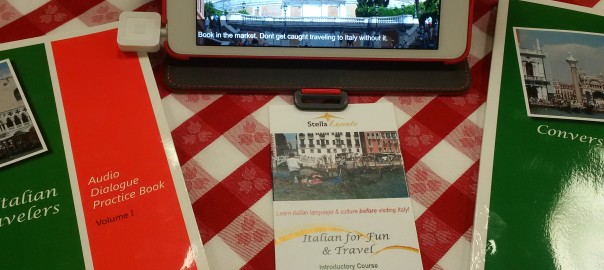 The Italian subjunctive mood can be used to make Italian hypothetical phrases and talk about love!
The Italian subjunctive mood can be used to make Italian hypothetical phrases and talk about love!
Can you speak Italian? By now, many of you have passed the beginning stages of learning to speak Italian and can read and comprehend quite a bit of the language. Meraviglioso!
But have you tried to take the next step to speak Italian fluently? Have you ever wondered about if something were to happen and just how you would express this idea in Italian?
Well, we can express hypothetical, or “if” ideas, called Italian hypothetical phrases, in several ways in Italian and often with the Italian subjunctive mood that we have been focusing on in this series!
This is the fourth blog post in the “Speak Italian” series that focuses on how to use the Italian subjunctive mood, or “il congiuntivo.” This blog and the one to follow (in November 2017) will complete our list of uses for the Italian subjunctive mood. For a complete list, see our last blog, Italian Subjunctive (Part 3): Speak Italian!
Let’s take that giant step from simple beginning sentences to more complex and fluid sentences in Italian! in this segment, we will discuss how to form Italian hypothetical phrases for probable and improbable “if” situations in Italian in the present. We will cover the phrases that start with “come se,” “magari,” and “ammesso che.” We will also learn how to use the verb chiedersi, which means “to wonder.”
We will learn how to conjugate the Italian imperfetto subjunctive and how to use the Italian conditional tense to construct our improbable Italian hypothetical phrases.
An example email between two friends talking about hypothetical situations of love will start our discussion! You may remember the characters and the story in the email from our recent Italian Subjunctive Mood Practice blog posts.
In the first three blog posts in the “Speak Italian” series about the subjunctive mood (“il congiuntivo”), we have presented Italian phrases that take the Italian subjunctive mood in the present and past tenses. For a review, see our last blog, Italian Subjunctive (Part 3): Speak Italian!
In this blog post, we will focus on how to construct Italian hypothetical phrases, as well as the different Italian verb forms needed for probable and improbable situations.
Read our “real-life” dialogue for examples that can be used as “anchors” in your knowledge for when you must speak Italian. Then next time you are wondering about something, start a conversation and use Italian hypothetical phrases!
Enjoy the fourth blog post in this series, “Italian Subjunctive (Part 4): Italian Hypothetical Phrases of Love”! —Kathryn Occhipinti
Some of this material is adapted from our textbook, Conversational Italian for Travelers © 2012 by Stella Lucente, LLC, found on www.learntravelitalian.com. Special thanks to Italian instructor Maria Vanessa Colapinto.
All phrases that take the Italian subjunctive mood have been underlined in this sample email. Try to pick out the Italian hypothetical phrases and then read about how to make your own Italian hypothetical phrases in the next section.
The characters Caterina and Susanna in our dialogue are cousins who grew up together in Abruzzo and now stay in touch with each other and discuss family happenings through email. Notice the many Italian idiomatic expressions that relate to dating and love, some of which are explained after each section.
Italian Hypothetical Phrases of Love
Una breve email tra due cugine
A brief email between two cousins
Cara Susanna,
Dear Susan,
È stato bellissimo vedere te e i tuoi figli quest’estate in Abruzzo. E poi, lo shopping a Roma è stato fantastico!
It was wonderful to see you and your children this summer in Abruzzo. And afterward, the shopping in Rome was fantastic!
Se io non fossi occupata all’università, verrei a trovarvi di nuovo a Roma!
If I weren’t so busy at college, I would come to visit you all again in Rome!
Forse quando la sessione di gennaio è finita, posso fare un viaggio.
Maybe when the exam session in January is over, I can take a trip.
Fammi sapere se tu sei libera per un weekend presto!
Let me know if you are free for a weekend soon!
Ma oggi sto scrivendo perché ho una buona notizia.
But today I am writing because I have good news.
La nostra cugina Anna ha incontrato un ragazzo molto simpatico quando è stata in Sicilia l’estate scorsa.
Our cousin Ann met a very nice boy when she was in Sicily last summer.
Lui si chiama Giovanni.
His name is John.
Anna mi ha mandato una foto. Mamma mia, è un figo da paura!*
Ann texted a photo to me. Wow, he is amazing!
Stanno insieme da un mese e frequentano la stessa università.
They have been (Italian: are [still]) together for a month and go to the same college.**
Secondo Anna, vanno molto d’accordo e sono gia una coppia.
According to Ann, they get along very well and are already a couple.
Se il tempo è bello, andranno al mare per il weekend a casa del papà di Giovanni.
If the weather is nice, they will go to the sea for the weekend to Giovanni’s father’s house.
A tutti e due piace molto la spiaggia e fare windsurf.
They both really like the beach and to go windsurfing.
Se Anna vuole andare al ristorante o al cinema, lui la porta.
If Ann wants to go to a restaurant or to the movies, he takes her.
Se lei vuole restare a casa, loro restano a casa insieme.
If she wants to stay at home, they stay at home together.
Mi sembra che siano innamorati.
It seems (to me) like they are in love.
Se Anna e il suo ex-fidanzato Paolo si fossero riconciliati, lei non sarebbe felice ora.
If Ann and her ex-boyfriend Paul had gotten back together, she would not be happy now.
Tu ricordi bene, sono sicura, come lui l’ha tradita, come le ha spazzato il cuore, e comunque erano gia agli sgoccioli da mesi prima.***
You remember well, I am sure, how he betrayed her, how he broke her heart, and anyway, they were already at the end of their relationship for months before.
Finalmente Anna si è resa conto che lui non era quello giusto per lei.
Finally, Anna realized that he was not right for her.
L’ha lasciato e ora quella storia (d’amore)**** è finita e un nuovo amore è cominciato per lei.
She left him and now that (love) story is over, and a new one (Italian: a new love) has begun for her.
Sono molto contenta per Anna!
I am very happy for Ann!
Forse tra un anno si sposano!
Maybe in a year, they (will) get married!
Scrivimi quando hai tempo!
Write me when you have time!
Tanti baci.
Lots of kisses.
Caterina.
*“Un figo da paura” refers to a young man who is handsome and sexy. Used alone, “Figo!” means “cool.”
And yes, “Mamma mia!” is still in use in Italy today. Variations include “Madre santa!” or simply “Maria!”
**In this case, Italian uses the present tense for an ongoing action, whereas English uses the past tense.
***The phrase “essere agli sgoccioli” literally means “to be at the last drops” and refers to when the last of the wine in the bottle is left and drips out. This phrase is used to suggest that the relationship is dying out and the couple is only seeing each other infrequently.
**** A romantic relationship between two people is usually described as “una storia,” the shortened form of “una storia d’amore,” or “a love story.”
****************************************************
Cara Caterina,
Dear Kathy,
Anch’io sono molto contenta per nostra cugina Anna!
I am also very happy for our cousin Ann!
Lei è molto bella e penso che anche Giovanni sia un bel ragazzo come dicevi.
She is very pretty, and I think he is also good looking from what (Italian: as) you have told me.
Lui sembra molto simpatico e mi sembra che lui la tratti molto bene.
He seems very nice, and it seems to me that he treats her very well.
Mi sembra che a loro piaccia molto frequentarsi.*
It seems (to me) that they like seeing each other very much.
Mi pare che non sia solo una cotta ma si piacciano da vero.
It seems to me that it is not only a crush but they really like each other.
Ma si stanno frequentando solamente da un mese!
But they have been seeing each other (English: dating) (for) only one month!**
Loro sono molto giovani, come te.
They are very young, like you.
Non si sa mai che cosa può succedere!
(Italian: One never knows) You never know what could happen!
Nè uno nè l’altro lavorano. Non hanno vissuto con un’altra persona. Non hanno soldi…
Neither one of them works. They have never lived with another person. They don’t have money…
Spero che loro aspettino almeno un anno prima di cominciare a parlare di matrimonio.
I hope that they wait at least a year before starting to talk about marriage!
Sarei molto contenta se tu venissi a trovarmi a febbraio.
I would be very happy if you were to come to see me in February.
A presto!
See you soon!
Susanna
*See the next section for comments about frequentarsi
**In this case, Italian uses the present tense for an ongoing action, whereas English uses the past tense.
******************************
Italian Hypothetical Phrases of Love
Talking about Relationships in Italian
Today in America, we “date,” “go out on a date,” or refer to two people who are “dating,” from the first romantic encounter until they become married. After they are married, they can still have “date nights.” But be careful when translating American romantic experiences into Italian! The English verb “to date” as used in America today to refer to a romantic relationship does not have a literal translation in Italian.
Of course, to “court” a woman was common in past centuries, and Italian language still reflects this. When a man tries to show he is interested in a woman, the phrase “fare la corte a…” is used from the verb corteggiare or “to court.”
If a woman wants to refer to dating a man, the following phrases can be used:
| “Mi vedo un ragazzo.” |
“I’m seeing a boy.” |
| “Esco con un ragazzo.” |
“I’m going out with a boy.” |
| “Il ragazzo con cui ho/avevo appuntamento.” |
“The boy with whom I have/had an appointment.” |
There is another verb still in use in Italy today that refers to a man seducing, or “winning over,” a woman: “conquistare a… ” If a woman lets herself be “won over” or “captivated” by a man, she can use the phrase “Mi lascio conquestare a…”
********************
If one friend wants to ask the other about his/her new love, they may say,
“Che tipo è lei?” or “Che tipo è lui?” meaning, “What is he/she like?” or, more simply, “Che tipo è?”
********************
There are two Italian phrases commonly used to refer to two people who have become romantically involved and are getting together regularly before marriage: “to go out with someone”—“uscire con qualcuno”—or “seeing each other”—“frequentarsi.”
To express a relationship between two people in Italian, and especially a close or romantic relationship, we can use the word “rapporto.”
Any relationship in general is considered a “relazione.” But be careful, as an “affair” outside of marriage is also a “relazione,” whereas “affari” refers to more general personal and business “affairs.”
********************
Finally, we know that many times romantic love comes to an end. How do we describe a “break up” in Italian? The verbs lasciare (to leave) and lasciarsi (to leave each other) come into play. From our dialogue:
L’ha lasciato e ora quella storia (d’amore) è finita e un nuovo amore è cominciato per lei.
She left him and now that (love) story is over, and a new one (Italian: a new love) has begun for her.
Below is an example sentence two people might use talk about a couple that has “broken up” or two people who have”left each other”
Loro si sono lasciati. They have broken up.
If you are one of the two people in the relationship and want to talk about “breaking up”:
Ci lasciamo stasera. We (will) break up/are breaking up tonight.
Non ci lasciamo, ma… We are not breaking up but…
Ci sono lasciati il mese scorso. We broke up last month.
How to Make Italian Hypothetical Phrases
“If” Phrases Refer to the Present:
Periodo Ipotetico con “Se” in Presente
To express complex thoughts and feelings, human beings have developed “hypothetical phrases”—phrases that enable us to think or wonder about situations that could occur. For instance, how many times have you said, “If I had…” or “If I were…”?
When we want to express the idea that something may happen in English, we most often start with a phrase that begins with the conjunction “if.”
The conjunction “if” starts a dependent clause in which we will describe a condition that could cause something else to happen. This dependent clause is then linked to a main clause that will describe the impending result or consequence that we are concerned about.
This sentence structure is the same in Italian, and the hypothetical clause in Italian starts with the word “se.” An Italian hypothetical phrase is called a “periodo ipotetico.”
Hypothetical phrases are composed using several different verb forms in English and Italian. For this blog post, we will talk about which Italian verb forms to use for the probable and improbable situations that may arise in the present and that are useful for every day conversation.
“Hold onto your hat!” as we say in English, because we will now start a “whirlwind tour” of the different types of hypothetical phrases that we can use to give depth to our Italian conversations. In the cases that we will present, knowledge of English will be very helpful. Read the technical information, but then focus on the actual phrases and you will soon see how thinking in English and Italian for this subject is really very similar!
Speak Italian: Italian Hypothetical Phrases of Love
You Will Need to Know…
How to Make Italian Hypothetical Phrases
Probable Situations
Hypothetical phrases in the present tense describe situations that are likely to happen, or probable situations.
In probable situations, the stated condition given in the “if” clause is a condition that a person may experience in the present and the consequence that will follow is a situation that will almost certainly happen.
A common example usually given for a probable hypothetical phrase relates to the weather, such as “If it rains, I will get wet when I go out.” We all know that given the condition just described, the resulting situation will happen to some extent!
The “if” phrase does not need to start the sentence, although it remains the dependent clause. Here is our example sentence again: “I will get wet when I go out if it rains.”
To Summarize: Italian Hypothetical Phrases for Probable Situations
| Italian Hypothetical Phrases—Probable Situations |
The condition described in the “if” clause and the consequence that will follow are probable;
both will almost certainly happen. |
********************
How to Make Italian Hypothetical Phrases
Probable Situations
If + Present Verb > Present or Future Verb
Now read the following table, which describes the sentence structure and the verb forms to use when creating a hypothetical sentence for a probable situation. This table compares how English and Italian approach this type of speech.
Italian Hypothetical Phrases:
Probable Situations |
|
English |
|
Italian |
| Condition (If) |
If + |
Present |
Se + |
Present (or Future*) |
Consequence
(Probable Result) |
|
Present or Future |
|
Present or Future |
From the table above, it is easy to see that English and Italian both express hypothetical, probable situations in a very similar way!
- In both English and Italian, for the condition in the dependent clause, we start with the conjunction “if” (“se” in Italian) and then use the simple present tense.
- In both English and Italian, when the dependent if/se clause starts with the present tense, the main clause that follows can use either the present or the future tense.
- Italian may use the future tense for the condition, or se clause for situations that are in the more distant future but are really likely to happen (really probable). (This does not occur in English.)
- *If the Italian dependent se clause is in the future tense, then the main clause that follows in Italian must also be in the future tense.
A review of the Italian future tense and the conjugations of the most commonly used Italian verbs in the future can be found in Chapters 15 and 16 of our textbook, Conversational Italian for Travelers.
To follow are some examples of the probable hypothetical situation from our dialogue, with our “if” condition and the consequence phrases underlined.
You will notice that we introduced these lines in the dialogue with the idea, or condition, that the characters Anna and Giovanni have become a couple; therefore, the consequence is that in the future, they will do everything together. And, for this couple, the consequence is almost certain to happen.
Se il tempo è bello, andranno al mare per il weekend a casa del papà di Giovanni.
If the weather is nice, they go (will go) to the sea for the weekend to Giovanni’s father’s house.
Se Anna vuole andare al ristorante o al cinema, lui la porta.
If Ann wants to go to a restaurant or to the movies, he takes (will take) her.
Se lei vuole restare a casa, loro restano a casa insieme.
If she wants to stay at home, they stay (will stay) at home together.
Speak Italian: Italian Hypothetical Phrases of Love
You Will Need to Know…
How to Make Italian Hypothetical Phrases
Probable Situations with a Command
Hypothetical phrases in the present tense can be used to refer to a situation and then give “advice” in the form of a direct command.
Phrases like “If you feel… (this way)” or “If you make/do… (something)” are very common in conversation. The speaker may describe a certain situation two people know to be likely, and then, without waiting for a reply, the speaker may give a command about what should be done in that situation. In the speaker’s mind, perhaps, that command will virtually always solve a perceived problem.
Think about how often parents give advice to their children in this way—without first waiting to hear how the children really feel! Here is a common exchange in my house, parent to child, of course. “Dinner will be ready in a half hour. Don’t eat cookies. If you are hungry, eat some fruit!”
The “if” phrase need not start the sentence in these cases, although it remains the dependent clause. Here is our example sentence again: “Eat some fruit if you are hungry!”
To Summarize: Italian Hypothetical Phrases for Probable Situations with a Command
| Italian Hypothetical Phrases—Probable Situations with a Command |
| The condition described in the “if” clause is probable, and the “advice” given in command form will almost certainly solve a problem, and/or result in the consequence that describes the future event. |
********************
How to Make Italian Hypothetical Phrases
Probable Situations with a Command
If + Present Verb > Imperative Verb
Now read the following table, which describes the sentence structure and the verb forms to use when creating a hypothetical sentence for a probable situation when giving a command. This table compares how English and Italian approach this type of speech.
| Italian Hypothetical Phrases:
Probable Situations
with a Command |
|
English |
|
Italian |
| Condition (If) |
If + |
Present |
Se + |
Present (or Future) |
Consequence
(Advice/Probable Result) |
|
Imperative |
|
Imperative |
From the table above, it is easy to see that English and Italian express hypothetical probable situations with a command in a very similar way!
- In English and Italian, for our condition in the dependent clause, we start with the conjunction “if” (“se” in Italian), and then most often use the simple present tense.
- For situations that are in the more distant future but are likely to happen (probable), Italian may use the future tense for the condition clause.
- For the consequence in the main clause, use the command verb form in English and Italian. The English command form is easy, and for the most part, we don’t even realize we are using it! Just remove the “to” from the infinitive form of the English verb. “To eat” is an infinitive in English. “Eat!” is a command.
- A review of the Italian command form will not be provided here, but can be found in Chapter 9 of our textbook, Conversational Italian for Travelers. (Note: In writing, Italian emphasizes that the command form is in use with an exclamation mark at the end of the sentence.)
Below is an example of a probable situation with a command from our dialogue, with our condition and consequence phrases underlined.
Fammi sapere se tu sei libera per un weekend presto!
Let me know if you are free for a weekend soon!
Speak Italian: Italian Hypothetical Phrases of Love
You Will Need to Know…
How to Make Italian Hypothetical Phrases
Improbable Situations
Hypothetical phrases in the subjunctive mood with the conditional tense describe situations in the present that are not likely to happen and therefore are improbable.
These types of phrases are used in order to “wonder” out loud or “suppose” what could happen in a particular situation if things were “different” from what we know to be true.
In improbable hypothetical situations, the stated condition given in the “if” clause and the consequence that will follow are situations that could happen (possible), but they are very unlikely to happen and are therefore improbable.
A common example often given for an improbable hypothetical phrase relates to money, such as, “If I were rich, I would travel to Italy.” Here, the condition as stated is unlikely; in general, one is usually either rich or not. This in turn makes the outcome unlikely to happen. With an improbable hypothetical phrase such as this, there may be a note of wishful thinking or irony in the statement. We are dealing with supposition, rather than a fact.
The “if” phrase does not need to start the sentence, although it remains the dependent clause. Here is our example sentence again: “I would travel to Italy if I were rich.”
In fact, I always remember this type of Italian sentence with the following rule: If you start a sentence with a phrase with the present conditional tense,” the imperfetto subjunctive mood must follow in the next phrase!
********************
Nearly Impossible Situations
Sometimes, a situation proposed for the present is so improbable that it is actually impossible, although it may be interesting to bring up in conversation. Think about how we sometimes pretend to be someone or something we know we cannot be. By wondering about these impossible situations, we are able to reveal a little something about ourselves and the world we actually live in.
For instance, I am someone who loves cats. What comes to my mind when I think of the cats I have here in America is an “easy” life. I may convey the complicated idea of how I might enjoy an “easy” life myself by relating my own life to the lives of my cats.
If I were a cat, I would live in a nice house and not have to work.
I would live in a nice house and not have to work if I were a cat.
Or, maybe I am someone who would like to change something about my appearance, which is easier today than in the past, but the condition and consequence are still impossible for me.
If my eyes were green, I could find work as a model.
I could find work as a model if my eyes were green.
To Summarize: Italian Hypothetical Phrases for Improbable Situations
| Italian Hypothetical Phrases—Improbable and Impossible Situations |
| The condition described in the “if” clause is improbable to varying degrees, and therefore is unlikely to result in the consequence that describes the future event one is wondering about. |
********************
How to Make Italian Hypothetical Phrases
Improbable Situations
If + Imperfetto Subjunctive Verb >
Present Conditional Verb
Now read the following table, which describes the sentence structure and the verb forms to use when creating a hypothetical sentence for an improbable situation when we want to wonder about something. This table compares how English and Italian approach this type of speech.
| Italian Hypothetical Phrases:
Improbable Situations |
|
English |
|
Italian |
Condition
(If: Wonder) |
If + |
Subjunctive |
Se + |
Imperfetto Subjunctive |
Consequence
(Supposition) |
|
Conditional |
|
Present Conditional |
From the table above, it is easy to see that English and Italian speakers think alike, although this may not be so evident to the English speaker at first.
Use of the subjunctive mood is becoming less common in English conversation, and even in some widely respected American newspapers and magazines.
Let’s digress for a moment, and give some English examples of the subjunctive mood:
- For instance, instead of “If I was…,” correct English would be “If I were…” to signal that the phrase to follow is hypothetical and the consequence unlikely.
- Or, instead of “If I saw…,” correct use of the subjunctive would be “If I had seen…” (It is never grammatically correct to say “I seen…,” despite what one may actually hear in some towns in America today!)
- To make matters more complicated, the English subjunctive form of many verbs is similar to the regular past tense form.
At any rate, let’s summarize how to make probable hypothetical phrases in English and Italian:
- In English and Italian, for the condition we are wondering about in the dependent clause, we start with the conjunction “if” (“se” in Italian), and then use the imperfetto subjunctive mood. ( A review of the imperfetto subjunctive mood for avere, essere, and stare, and -are, -ere, -ire infinitive verbs will follow this section.)
- For the consequence/supposition in the main clause, use the present conditional tense in English and Italian.
Below are some examples of phrases that used possible hypothetical situations from our dialogue, with our condition and consequence phrases underlined.
Se io non fossi occupata all’università, verrei a trovarvi di nuovo a Roma!
If I weren’t so busy at college, I would come to visit you all again in Rome!
Sarei molto contenta se tu fossi venire a trovarmi a febbraio.
I would be very happy if you were to come to see me in February.
Speak Italian: Italian Hypothetical Phrases of Love
You Will Need to Know…
How to Make Italian Hypothetical Phrases
“Come se” and “Magari”
********************
“Come se…”
Hypothetical phrases can start with the phrase “Come se,” which translates into the phrase “as if.” This phrase falls into the realm of hypothetical phrases since the comparison is with a characteristic or action that is improbable. It should be noted that, in Italian, the word “se” in this type of comparison phrase is sometimes omitted (see our last example).
Therefore, come se, is an improbable hypothetical phrase, so it must always take the imperfetto subjunctive verb form in the present tense. (In the past tense, the phrase come se takes the trapssato subjunctive form, which will be the subject of the next blog.)
In English, as in Italian, the “as if” improbable hypothetical phrase will also use the subjunctive verb form.
Common phrases that use come se compare actions and characteristics of individuals in an attempt to make a point in a dramatic way. These “as if” phrases may be flattering:
Il mio amico inglese non ha practicamente accento quando lui parla in italiano, come se fosse un vero italiano!
My British friend has virtually no accent when he speaks Italian, as if he were a real Italian!
We often use this type of phrase to talk ironically about a situation, or to show our displeasure about something that has happened. For instance, I may be be shopping and a salesperson may try to sell me a pair of shoes that are way too expensive for my budget. (Isn’t this always a problem, for both women and men?) I might say something like:
Mi mostra le scarpe più costose che ha, come se io fossi ricca!
She shows me the most expensive shoes they have, as if I were rich!”
A line from a novel by Gianrico Carofiglio, Testimone inconsapevole illustrates how this “as if” phrase can be used to emphasize an important point. The line is spoken by the main character, who is the narrator of the book. He relays the conversation he and his wife had when his wife tells him that she is filing for divorce. One of the reasons his wife gives for the divorce is that she feels humiliated because her husband thinks she has not noticed his many affairs – in effect treating her as if she were stupid. Clearly, she believes she is a smart woman, and notes with irony that he would chose to treat as if she were not. From page 16:
“Quello che l’aveva più umiliata non era la mia infedelità… ma il fatto che le avessi veramente mancato di rispetto trattandola come fosse una stupida.”
“That which had humiliated her the most was not my infidelity… but the fact that I had truly lost respect for her, treating her as if she were an idiot.”
********************
“Magari…”
“Magari” is a colorful and commonly used Italian word. Make an Italian friend and you will no doubt hear this word! Magari can be used as an adverb and in this case means, “even if.” Magari is most often used as an interjection, with the rough meaning of “if only…” or “I wish…” when the “I wish” is a statement of something that is unlikely to happen.
Magari is always followed by an imperfetto subjunctive verb in the present tense (and the trapassato subjunctive in the past tense) and takes the subjunctive in English as well.
For instance , let’s say I am talking to someone about my love of Italy. They may mention that I should spend my summer there. My response:
Magari, questo fosse possibile!
I wish/If only this were possible!
Speak Italian: Italian Hypothetical Phrases of Love
You Will Need to Know…
How to Make Italian Hypothetical Phrases
“Ammesso che…”
********************
A very common way to start an Italian conversation about a complex topic is with the phrase “Ammesso che…” which translates into “Assuming that…” This phrase falls into the realm of hypothetical phrases because, by definition, the speaker does not know if the facts to be discussed are true or not. The phrase implies a starting point from which a discussion on a topic can begin, often in the hopes of uncovering the answer to a difficult question, or somehow finding a fact or the truth behind a certain situation.
Since the phrase “Ammesso che…“ is by definition uncertain, the phrase that follows must always be in the subjunctive mood.
********************
In some cases, the speaker knows already that it will be possible to uncover a fact or the truth behind a situation. He just needs to make the right assumption or ask the right questions to get his answer. In these cases, “Ammesso che…” will be followed by a verb in the present subjunctive mood, just as the other verbs in Rule 4 that we learned about in our very first blog on the subjunctive mode.
After the assumption is posed, a third phrase will complete the sentence to describe what the speaker thinks will be the end result. Naturally, this final phrase will be in the future tense, since it is a prediction.
In English, the verb in the phrase to follow “Assuming that…” will be in the simple present tense and the third, final phrase will be in the future tense.
Common phrases that start with “Ammesso che…” could invoke a reflection about an individual’s character, or what that individual says or does.
Ammesso che lui sia… bello/gentile/intelligente… lui sarà un bravo fidanzato.
Assuming that he is… handsome/kind/intelligent… he will be a wonderful fiance.
Ammesso che lei dica… che tutto va bene… cominceremo il lavoro lunedì prossimo.
Assuming that she says... everything is good to go… we can start work next Monday.
Ammesso che tu possa… prendere le vacanze in agosto… andremo al Lago Maggiore.
Assuming that you can… take vacation in August… we will go to Lake Maggiore.
********************
In some cases, the speaker knows already that it will be nearly impossible to uncover a fact or the truth behind a situation. Or possibly the speaker has a wish for the future that he knows is unlikely to come about. But he is trying to come to some conclusion anyway, or figure out a way to make something happen. In these cases, “Ammesso che…” will be followed by a verb in the imperfetto subjunctive mood.
After the assumption is posed, a third phrase will complete the sentence to describe what the speaker thinks will be the end result. Naturally, since we are working with the imperfetto, this final phrase will be in the conditional tense, either present or past, depending on the situation.
In English, the verb in the phrase to follow “Assuming that…” will also be in the subjunctive mood to reflect the improbability of the situation and the third, final phrase will be in the present or past conditional tense, just like in Italian.
Common phrases that start with “Ammesso che…” could invoke a reflection about an individual’s character, or what that individual says or does. There may be a hint of irony in these phrases with the use of the imperfetto, as the speaker makes an assumption he already knows will be unlikely to happen. Let’s try our examples above, this time creating nearly impossible characteristics or situations.
Ammesso che lui fosse… ricco/famoso/un presidente … lui potrebbe essere un bravo fidanzato.
Assuming that he were… rich/famous/a president… he would be a wonderful fiance.
Ammesso che lei dicesse… di aver vinto la lotteria… avremmo cominciato/ avremmo potuto cominciare il lavoro lunedì prossimo.
Assuming that she had said… she has won the lottery… we could start/ could have started work next Monday.
Ammesso che tu potessi… smettere di lavorare ogni Domenica… potemmo andare al Lago Maggiore.
Assuming that you could… stop working every Sunday… we could go to Lake Maggiore.
Speak Italian: Italian Hypothetical Phrases of Love
You Will Need to Know…
How to Make Italian Hypothetical Phrases
“Chiedersi”
********************
Finally, no discussion on Italian hypothetical phrases would be complete without mention of the verb chiedersi, which is the verb Italians use to describe the idea of “wondering if…” something might happen.
“Mi chiedo…” literally means, “I ask myself,” which translates into “I wonder.” At first glance, it may seem like this verb should fall into the category of improbable hypothetical phrases – especially when this verb is followed by se, such as in the phrase “I wonder if…” But, cheidersi takes the present and past tense (passato) subjunctive forms, just as the other verbs in Rule 4 that we learned about in our very first blog on the subjunctive mode.
So, you already know how to use this verb if you have read the first blog in this series!
Here are some examples for when one is wondering in the present tense about something that happened in either the present or the past. Notice the use of either the present subjunctive mood or the passato subjunctive mood.
Mi chiedo se lui sia un attore bravo in quel film.
I wonder if he is a great actor in that film.
Mi chiedo se lui sia stato un attore bravo in quel film.
I wonder if he was a great actor in that film.
The Imperfetto Subjunctive Mood
Auxiliary Verbs – “Essere, Avere, Stare”
The most commonly used improbable hypothetical phrases begin with the words, “If I were…” or “If I had…”
So in Italian, the two most important phrases using the imperfetto subjunctive to remember are, “Se io fossi…” and “Se io avessi…” using the imperfetto subjunctive conjugations for essere and avere.
Below are the imperfetto subjunctive conjugations for the auxiliary verbs in Italian. You will notice that avere has a regular conjugation, whereas essere and stare have irregular conjugations. The stressed syllables are underlined.
In hypothetical clauses, because the imperfetto subjunctive mood is introduced by se, (se) is included in the subject pronoun column as a reminder. When conjugating these verbs, say “se” before the subject pronoun and each verb form to reinforce this way of thinking!
Avere—to have—Imperfetto Subjunctive Mood
| (se) io |
avessi |
I had |
| (se) tu |
avessi |
you (familiar) had |
| (se) Lei
(se) lei/lui |
avesse |
you (polite) had
she/he had |
| |
|
|
| (se) noi |
avessimo |
we had |
| (se) voi |
aveste |
you all had |
| (se) loro |
avessero |
they had |
Essere—to be—Imperfetto Subjunctive Mood
| (se) io |
fossi |
I were |
| (se) tu |
fossi |
you (familiar) were |
| (se) Lei
(se) lei/lui |
fosse |
you (polite) were
she/he were |
| |
|
|
| (se) noi |
fossimo |
we were |
| (se) voi |
foste |
you all were |
| (se) loro |
fossero |
they were |
Stare—to stay/be—Imperfetto Subjunctive Mood
| (se) io |
stessi |
I stayed/were |
| (se) tu |
stessi |
you (familiar) stayed/were |
| (se) Lei
(se) lei/lui |
stesse |
you (polite) stayed/were
she/he stayed/were |
| |
|
|
| (se) noi |
stessimo |
we stayed/were |
| (se) voi |
steste |
you all stayed/were |
| (se) loro |
stessero |
they stayed/were |
The Imperfetto Subjunctive Mood
Regular “-are, -ere, -ire” Conjugations
Improbable hypothetical phrases always take the imperfetto subjunctive mood in Italian, and as we have seen in the last sections.
But, the imperfetto subjunctive mood has other uses. Specifically, it is necessary with all of our many clauses that trigger the Italian subjunctive mood when we are speaking in the past tense. We will go over these rules in detail in later blogs.
For now, we will simply discuss the complete conjugation of the imperfetto subjunctive mood, which is actually quite easy. So, keep the knowledge of how to conjugate the imperfetto subjunctive mood handy for when we discuss its many uses!
Luckily, there are only a few irregular stem forms to learn for the imperfetto subjunctive mood, making it an easier tense to learn than the present, future, and conditional tenses.
Finally, the imperfetto subjunctive mood endings are always regular and will be the same for all three conjugations!
********************
To conjugate the imperfetto subjunctive mood…
As usual, we must first make our stem from the infinitive –are, -ere, and –ire verbs. The method used to form the stems for the imperfetto subjunctive mood is easy – just drop the –re from the infinitive verb!
This will create stems that end in the letters –a for the –are verbs, -e for the –ere verbs, and –i for the –ire verbs. Then, add the following endings below to the stems for all three conjugations:
Subjunctive Mood – Imperfetto Endings
| io |
ssi |
| tu |
ssi |
| Lei/lei/lui |
sse |
| |
|
| noi |
ssimo |
| voi |
ste |
| loro |
ssero |
The following table will put together our stems with our imperfetto subjunctive mood endings. A few notes about this:
When pronouncing the imperfetto subjunctive mood verbs, the stress will always be on the syllable that begins with the last two letters of the stem and will incorporate one –s letter from the ending. (Remember the rule for Italian double consonants: one consonant will go with the syllable before and the second with the syllable after, in effect also stressing the double consonant itself.) The stressed syllables are underlined in our example table below.
Notice that English uses the simple past tense to express the same idea in improbable hypothetical phrases. Or, alternatively,“were + infinitive form or gerund.” Examples in English: “If I were to live…” or “If I were living…” Also, “had + past participle,” such as, “If I had seen…”
Imperfetto Subjunctive Mood – Example Verb Conjugations
| |
Abitare
(to live)
(lived/were living) |
Vedere
(to see)
(saw/had seen) |
Finire
(to finish)
(finished/were finishing) |
| io |
abitassi |
vedessi |
finissi |
| tu |
abitassi |
vedessi |
finissi |
| Lei/lei/lui |
abitasse |
vedesse |
finisse |
| |
|
|
|
| noi |
abitassimo |
vedessimo |
finissimo |
| voi |
abitaste |
vedeste |
finiste |
| loro |
abitassero |
vedessero |
finissero |
The Imperfetto Subjunctive Mood
Commonly Used Regular Verbs
Luckily, most verbs are regular in the imperfetto subjunctive mood. So, there are many, many more regular than irregular verbs! Below are some commonly used regular verbs. Practice saying them out loud and listen to how each conjugated verb sounds.
Notice that English uses the simple past tense to express the same idea in improbable hypothetical phrases. Or, alternatively, were + infinitive form or gerund. ” English examples: “If I were to go…” or “If I were going…” Also, “had + past participle,” such as, “If I had seen…”
|
Imperfetto Subjunctive Mood Conjugations – Commonly Used Regular Verbs
|
|
Andare
(to go)
(went/were going) |
Sapere
(to know)(knew/had known) |
Venire
(to come)
(came/had come) |
Vivere
(to live)
(lived/were living) |
| io |
andassi |
sapessi |
venissi |
vivessi |
| tu |
andassi |
sapessi |
venissi |
vivessi |
| Lei/lei/lui |
andasse |
sapesse |
venisse |
vivesse |
| |
|
|
|
|
| noi |
andassimo |
sapessimo |
venissimo |
vivessimo |
| voi |
andaste |
sapeste |
veniste |
viveste |
| loro |
andassero |
sapessero |
venissero |
vivessero |
The Imperfetto Subjunctive Mood
Commonly Used Irregular Verbs
There are a few important irregular verbs to know in the imperfetto subjunctive mood. You will find them in the tables below. Practice saying them out loud and listen to how each conjugated verb sounds.
Notice that English uses the simple past tense to express the same idea in improbable hypothetical phrases. Or, alternatively, “were + infinitive form or gerund, ” such as, “If I were to make…” or “If I were making…” Also, “had + past participle,” such as, “If I had seen…”
Fare – to do/make – Imperfetto Subjunctive Mood
| io |
facessi |
I did/ made |
| tu |
facessi |
you (familiar) did/made |
| Lei
lei/lui |
facesse |
you (polite) did/made
she/he did/made |
| |
|
|
| noi |
facessimo |
we did/made |
| voi |
faceste |
you all did/made |
| loro |
facessero |
they did/made |
Dare – to give – Imperfetto Subjunctive Mood
| io |
dessi |
I gave |
| tu |
dessi |
you (familiar) gave |
| Lei
lei/lui |
desse |
you (polite) gave
she/he gave |
| |
|
|
| noi |
dessimo |
we gave |
| voi |
deste |
you all gave |
| loro |
dessero |
they gave |
Dire – to say/tell – Imperfetto Subjunctive Mood
| io |
dicessi |
I said/told |
| tu |
dicessi |
you (familiar) said/told |
| Lei
lei/lui |
dicesse |
you (polite) said/told
she/he said/told |
| |
|
|
| noi |
dicessimo |
we said/told |
| voi |
diceste |
you all said/told |
| loro |
dicessero |
they said/told |
Grammar Note: The Italian Conditional Tense
The conditional tense is used to make a polite request, as we learned way back in Chapter 4 of our Conversational Italian for Travelers textbook, when we discussed how to use the word vorrei, which means “I would like” or “I wish.” In the “Important Phrases” section of Chapter 16, we also learned how to use the word vorremmo, which means, “we would like,” which comes in handy at a restaurant when ordering for the table.
Notice that the meaning of a conditional verb is rendered in English with the combination of “would + infinitive verb.” The conditional tense, in summary, expresses a want or wish, an intention, a duty, or a preference.
The method used to form the stems for the Italian conditional tense is exactly the same as the method to form the Italian future tense. Also, the irregular stems for the conditional tense are identical to those for the future tense. The Italian conditional endings are always regular and will be the same for all three conjugations!
Please see Chapters 17 and 18 of the Conversational Italian for Travelers textbook for a review of how to conjugate the conditional tense in Italian.
*************************
Grammar Note: Present versus Conditional Tense
The Meaning of the Modal Verbs
“Dovere, Potere, Volere”
Throughout our Conversational Italian for Travelers textbook, we have emphasized the polite forms of volere (vorrei, vorremmo) in the conditional tense and recommended using this form to make requests for oneself or for a group. The English translation for the conditional verbs in general is that of “would + infinitive verb,” which describes a request or a wish, rather than a demand or an order.
Here are two examples below of the same request that might be made in a restaurant to a waiter, first in the present tense, and then in the conditional tense. The first, in the present tense, sounds more demanding and insistent. The second, in the conditional tense, sounds less forceful, as it describes a preference or wish rather than a definite need.
Voglio un tavolo vicino alla finestra. I want a table by the window.
Vorrei un tavolo vicino alla finestra. I would like/wish to have a table by the window.
Let’s take a look at the other modal, or helping, verbs and see what connotation the conditional tense lends to them. For dovere, the idea relayed in the present tense is a forceful must. With devo (I must), we are led to understand that the action that follows has to be completed, no matter what else may come to pass. The conditional dovrei translates into “I should” or “I ought to,” which gives a feeling of necessity but also implies a bit of indecisiveness and an uncertainty as to whether the speaker believes the action described will be completed. Here are two examples using each tense:
Devo visitare mia nonna domenica. I must visit my grandmother Sunday.
Dovrei visitare mia nonna domenica. I should visit my grandmother Sunday.
For the verb potere, the present tense “posso” translates as “I can” and can be used to ask “May I?” “Può,” the present tense “polite you” form, is also used to make a polite request and in these situations means, “Could you?” The conditional form we have just learned also translates as “could” and may be heard while traveling in Italy. Here are some commonly used phrases:
Mi può auitare? Could you(polite) help me?
Potrebbe aiutarmi? Could you (polite) help me?
Ti posso aiutare? May I help you (familiar)?
Potrei aiutarla? May I help you (polite)?
The Imperfetto Subjunctive Mood
Modal Verbs – “Dovere, Potere, Volere”
The imperfetto subjunctive forms of the modal, or helping verbs, are used frequently in conversation. All have regular stems, and of course, regular endings – as all imperfetto subjunctive mood verbs have regular endings! Here is a summary of the imperfetto subjunctive mood conjugations for all three modal verbs together, for easy reference.
Notice that the English translation for these verbs is in the conditional tense.
Dovere – to have to – Imperfetto Subjunctive Mood
| io |
dovessi |
I should |
| tu |
dovessi |
you (familiar) should |
| Lei/lei/lui |
dovesse |
you (polite) she/he should |
| |
|
|
| noi |
dovessimo |
we should |
| voi |
doveste |
you all should |
| loro |
dovessero |
they should |
|
|
|
|
Potere – to can – Imperfetto Subjunctive Mood
| io |
potessi |
I could |
| tu |
potessi |
you (familiar) could |
| Lei/lei/lui |
potesse |
you (polite) she/he could |
| |
|
|
| noi |
potessimo |
we could |
| voi |
poteste |
you all could |
| loro |
potessero |
they could |
Volere – to want – Imperfetto Subjunctive Mood
| io |
volessi |
I would like |
| tu |
volessi |
you (familiar) would like |
| Lei/lei/lui |
volesse |
you (polite) she/he would like |
| |
|
|
| noi |
volessimo |
we would like |
| voi |
voleste |
you all would like |
| loro |
volessero |
they would like |
 Kathryn Occhipinti, MD, author of the
Kathryn Occhipinti, MD, author of the
Conversational Italian for Travelers series of books, is a teacher of Italian for travelers to Italy in the Peoria and Chicago area. “Everything you need to know to enjoy your visit to Italy!”Join my Conversational Italian! Facebook group and follow me on Twitter at StellaLucente@travelitalian1 and start to learn Italian today for FREE!
Conversational Italian! Facebook Group
Tweet Stella Lucente Italian
YouTube Stella Lucente Italian, LLC
More information on and photographs of Italy can be found on these Stella Lucente Italian sites:
Facebook Stella Lucente Italian
Pinterest Stella Lucente Italian
Visit learntravelitalian.com/download.html to purchase/download Conversational Italian for Travelers and find more interesting facts and helpful hints about getting around Italy! Learn how to buy train tickets online, how to make international and local telephone calls, and how to decipher Italian coffee names and restaurant menus, all while gaining the basic understanding of Italian that you will need to know to communicate easily and effectively while in Italy. —From the staff at Stella Lucente, LLC
Italian Subjunctive (Part 4) : Italian Hypothetical Phrases of Love
Speak Italian like a native when you use the Italian verb “Prendere”!















